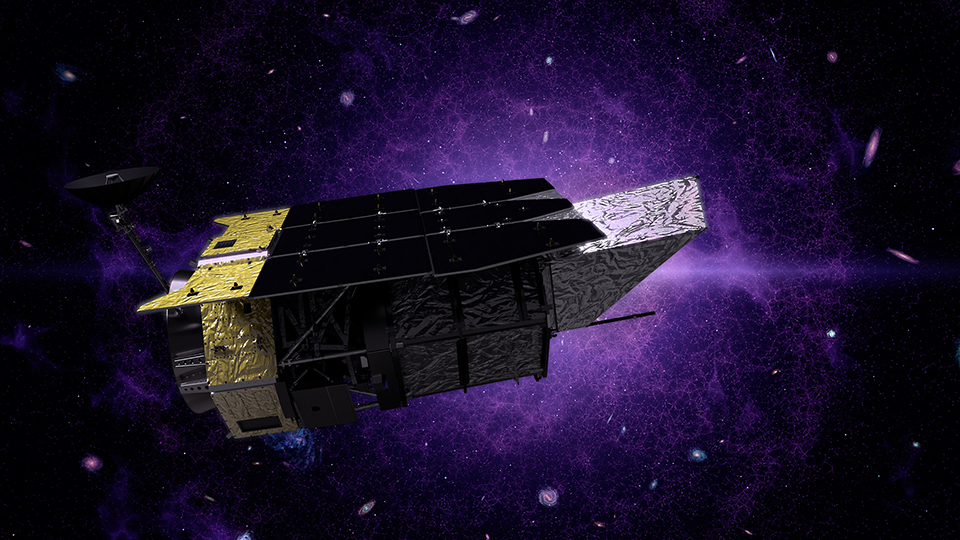The Roman Space Telescope will be launched in 2027 to discover the true nature of dark energy
- The mission, in which researcher Lluís Galbany from the Institute of Space Sciences (ICE-CSIC) and the IEEC participates, aims to determine the expansion history of the universe and to test possible explanations for its apparent acceleration
- The Roman Space Telescope will measure light from a billion galaxies over the course of the mission lifetime

Caption: Spacecraft Visualisation of the Nancy Grace Roman Space Telescope.
Credits: GSFC/SVS.
NASA’s Nancy Grace Roman Space Telescope (or Roman for short), an observatory designed to settle essential questions in the areas of dark energy, exoplanets, and infrared astrophysics, is planned to be launched in 2027. A research group focused on supernovae, in which Lluís Galbany, researcher from the Institute of Space Studies of Catalonia (IEEC — Institut d’Estudis Espacials de Catalunya) at the Institute of Space Sciences (ICE-CSIC) participates, has been awarded $11 million to develop the tools needed to utilise as cosmological probes the thousands of supernovae (exploding stars) that Roman will discover, and constrain the true nature of the mysterious dark energy that permeates our Universe.
Roman has a primary mirror that is 2.4 metres in diameter—the same size as the Hubble Space Telescope’s primary mirror. But, unlike Hubble, which can only observe a tiny patch of sky, Roman’s field of view is 200 times greater than the Hubble infrared instrument, capturing more of the sky with less observing time. Its primary instrument, the Wide Field Instrument, will measure light from a billion galaxies over the course of the mission lifetime.
With this incredible tool, one of the mission’s key objectives is to determine the expansion history of the universe and to test possible explanations for its apparent acceleration, including dark energy and modifications to general relativity.
From ICE-CSIC, the supernova research group will be in charge of developing the part of the pipeline responsible for performing the supernova host galaxy linear reconstruction and analysis, and the infrastructure to evaluate the type of the supernova and to characterise their spectroscopic features from Roman’s prism spectra. “The whole collaboration and in particular our supernovae group at ICE-CSIC are very excited about this new challenge. We will be able to observe the furthest type Ia supernovae humans ever have seen, which exploded just 2 billion years after the Big Bang”, said Galbany.
These ultra-precise measurements are not sufficient on their own. Figuring out what they mean requires modelling of how these measurements would differ in varying cosmological scenarios, so the team will also produce model catalogues of supernovae that we would expect to observe in these different conditions.
Contactes
IEEC Communication Office
Barcelona, Spain
E-mail: comunicacio@ieec.cat
Lead Researcher at the IEEC
Barcelona, Spain
Lluís Galbany
Institute of Space Studies of Catalonia (IEEC)
Institute of Space Sciences (ICE-CSIC)
E-mail: lgalbany@ieec.cat
About the IEEC
The Institute of Space Studies of Catalonia (IEEC — Institut d’Estudis Espacials de Catalunya) promotes and coordinates space research and technology development in Catalonia for the benefit of society. IEEC fosters collaborations both locally and worldwide and is an efficient agent of knowledge, innovation and technology transfer. As a result of more than 25 years of high-quality research, done in collaboration with major international organisations, IEEC ranks among the best international research centres, focusing on areas such as: astrophysics, cosmology, planetary science, and Earth Observation. IEEC’s engineering division develops instrumentation for ground- and space-based projects, and has extensive experience in working with private or public organisations from the aerospace and other innovation sectors.
The IEEC is a non-profit public sector foundation that was established in February 1996. It has a Board of Trustees composed of the Generalitat de Catalunya, Universitat de Barcelona (UB), Universitat Autònoma de Barcelona (UAB), Universitat Politècnica de Catalunya · BarcelonaTech (UPC), and the Spanish Research Council (CSIC). The IEEC is also a CERCA centre.
